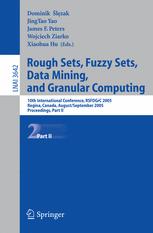

Most ebook files are in PDF format, so you can easily read them using various software such as Foxit Reader or directly on the Google Chrome browser.
Some ebook files are released by publishers in other formats such as .awz, .mobi, .epub, .fb2, etc. You may need to install specific software to read these formats on mobile/PC, such as Calibre.
Please read the tutorial at this link: https://ebookbell.com/faq
We offer FREE conversion to the popular formats you request; however, this may take some time. Therefore, right after payment, please email us, and we will try to provide the service as quickly as possible.
For some exceptional file formats or broken links (if any), please refrain from opening any disputes. Instead, email us first, and we will try to assist within a maximum of 6 hours.
EbookBell Team

4.3
48 reviewsThis volume contains the papers selected for presentation at the 10th Int- national Conference on Rough Sets, Fuzzy Sets, Data Mining, and Granular Computing, RSFDGrC 2005, organized at the University of Regina, August 31st–September 3rd, 2005. This conference followed in the footsteps of inter- tional events devoted to the subject of rough sets, held so far in Canada, China, Japan,Poland,Sweden, and the USA. RSFDGrC achievedthe status of biennial international conference, starting from 2003 in Chongqing, China. The theory of rough sets, proposed by Zdzis law Pawlak in 1982, is a model of approximate reasoning. The main idea is based on indiscernibility relations that describe indistinguishability of objects. Concepts are represented by - proximations. In applications, rough set methodology focuses on approximate representation of knowledge derivable from data. It leads to signi?cant results in many areas such as ?nance, industry, multimedia, and medicine. The RSFDGrC conferences put an emphasis on connections between rough sets and fuzzy sets, granularcomputing, and knowledge discoveryand data m- ing, both at the level of theoretical foundations and real-life applications. In the case of this event, additional e?ort was made to establish a linkage towards a broader range of applications. We achieved it by including in the conference program the workshops on bioinformatics, security engineering, and embedded systems, as well as tutorials and sessions related to other application areas.